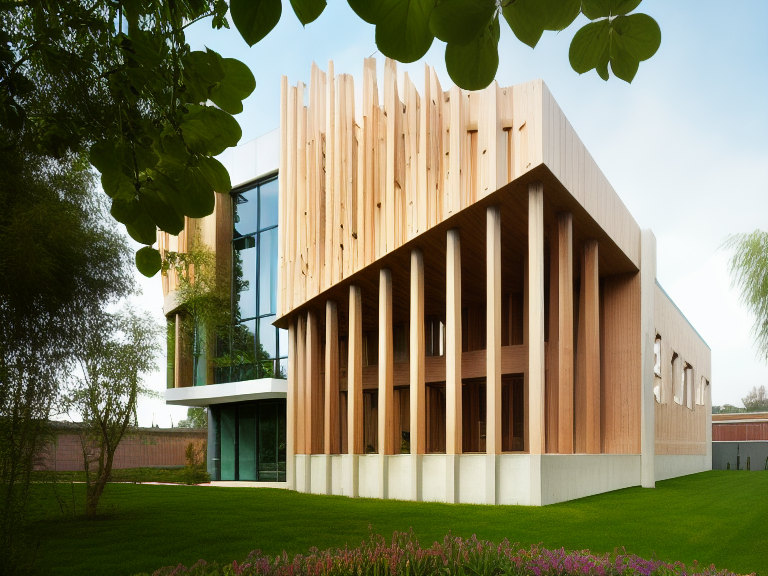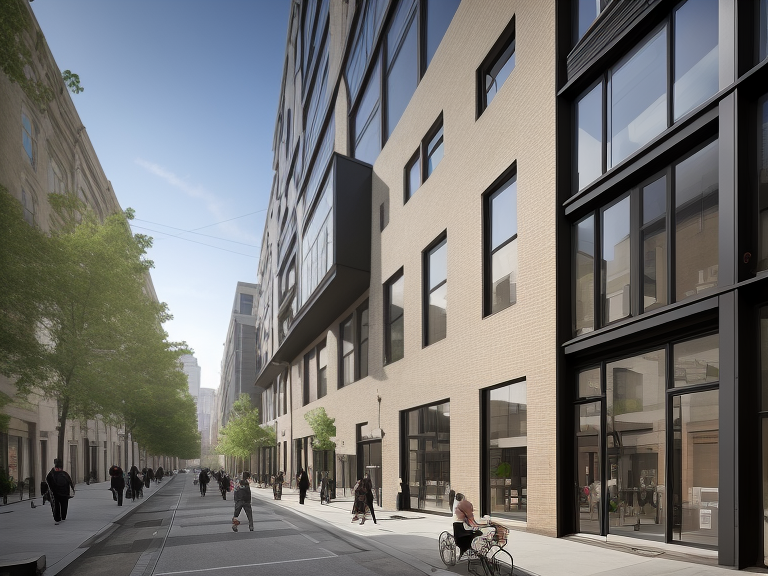Modern office design is evolving to prioritize harmony, functionality, and sustainability, recognizing the profound impact of physical work environments on employee well-being, creativity, and productivity. Biophilic design incorporates natural elements, while flexible workspaces cater to diverse work styles. Acoustic comfort and wellness-oriented design also take center stage. Technology integration, sustainable materials, and minimalistic approaches further enhance the workspace. Activity-based workspaces and art installations stimulate collaboration and creativity. As offices become hubs for innovation and growth, these trends are redefining the modern workspace. Explore the latest developments shaping the future of office design.
Biophilic Design Takes Center Stage
Biophilic Design Takes Center Stage
As the modern workplace continues to evolve, biophilic design has emerged as a dominant trend, with architects and designers incorporating natural elements and materials to create spaces that not only promote occupant well-being but also boost productivity and creativity. This design approach recognizes the intrinsic human desire to connect with nature, and its benefits are twofold. On one hand, it fosters a sense of calm and relaxation, reducing stress and anxiety. On the other hand, it stimulates the mind, sparking innovation and creativity.
Flexible Workspaces for Modern Needs
As the nature-inspired design elements of biophilic spaces foster a sense of calm and stimulate innovation, modern workplaces are also adapting to the evolving needs of employees by incorporating flexible workspaces that accommodate diverse work styles and preferences. This shift acknowledges that one-size-fits-all approaches are no longer effective, and that employees require tailored environments to thrive.
To achieve this, companies are employing various strategies to create flexible workspaces. These include:
| Strategy | Description |
|---|---|
| Task Segmentation | Dividing work into focused tasks to enhance productivity |
| Space Allocation | Assigning spaces based on workstyle and task requirements |
| Resource Optimization | Allocating resources efficiently to minimize waste |
| Workstyle Analysis | Identifying individual work styles to inform space design |
Acoustic Comfort in Open Plans
How can open-plan offices balance the need for collaboration with the imperative of acoustic comfort, particularly in spaces where distractions can hinder productivity? The answer lies in innovative design solutions that prioritize acoustic comfort without sacrificing collaboration. One effective strategy is the implementation of sound masking technology, which involves adding a constant, soothing background noise to the environment. This can help to reduce distractions and create a more focused work environment.
Another key consideration is noise reduction through the strategic use of materials and design elements. For example, incorporating acoustic panels, sound-absorbing materials, and strategically placed partitions can help to minimize distractions and create a more peaceful atmosphere. By combining these design elements with sound masking technology, open-plan offices can create an environment that supports both collaboration and acoustic comfort.
Wellness-Oriented Office Design
In addition to minimizing distractions, forward-thinking office designers are now prioritizing employee wellness by incorporating elements that support physical and mental health, leading to a more holistic approach to office design. This shift in focus acknowledges the profound impact that work environments have on overall well-being.
Wellness-oriented office design encompasses a broad range of considerations, including Mindful Ergonomics. By carefully selecting furniture and layouts that promote comfortable postures, reduce eye strain, and minimize repetitive strain injuries, designers can greatly enhance employee health. This attention to detail not only boosts productivity but also fosters a sense of care and investment in employees' well-being.
Another important aspect of wellness-oriented design is the encouragement of Healthy Habits. This can be achieved through the strategic placement of amenities, such as meditation rooms, fitness centers, and healthy food options. By providing access to these resources, employers can empower employees to make healthier choices and cultivate a more balanced lifestyle. Additionally, incorporating natural elements, such as green walls, living roofs, and abundant natural light, can have a profound impact on mental health and mood. By prioritizing wellness in office design, companies can reap the benefits of a happier, healthier, and more productive workforce.
Technology Integration for Productivity
As offices aim to enhance productivity, the strategic integration of technology is becoming an essential aspect of office design. By incorporating innovative tools and systems, organizations can streamline communication, enhance collaboration, and optimize workflow. From smart meeting room tools to collaborative software solutions and efficient data management systems, technology integration holds the key to unlocking peak productivity in the modern workplace. Additionally, the influence of smart home technology trends is shaping modern office environments, introducing automation and connectivity that improve efficiency. Features such as voice-activated assistants, IoT-enabled devices, and adaptive lighting systems contribute to a seamless and productive workspace. By embracing these advancements, organizations can create dynamic and responsive offices that meet the evolving needs of their workforce.
Smart Meeting Room Tools
Productivity and collaboration in modern offices have been revolutionized by the integration of smart meeting room tools, which seamlessly merge innovative technology with traditional meeting spaces. These tools enhance the meeting experience, fostering more efficient and effective communication. One notable example is the incorporation of Virtual Whiteboards, which enable real-time collaboration and brainstorming sessions. Another significant tool is the integration of Virtual Assistants, which can schedule meetings, take notes, and even provide language translation services.
| Tool | Description | Benefits |
|---|---|---|
| Virtual Whiteboards | Interactive digital canvas for brainstorming | Enhances collaboration, increases engagement |
| Virtual Assistants | AI-powered meeting facilitation | Streamlines meeting organization, improves productivity |
| Wireless Presentation Systems | Seamless content sharing | Simplifies presentation setup, reduces distractions |
| Acoustic Analytics | Real-time meeting analytics | Provides valuable insights, optimizes meeting dynamics |
Collaborative Software Solutions
Central to the modern office's pursuit of efficiency is the strategic integration of collaborative software solutions, which empower teams to work in tandem and drive innovation. By leveraging these digital tools, businesses can foster a culture of collaboration, creativity, and productivity. Virtual Whiteboards, for instance, enable teams to brainstorm and ideate in a shared digital space, facilitating real-time collaboration and reducing the need for tedious note-taking. Meanwhile, Digital Hubs serve as centralized platforms for team communication, project management, and file sharing, ensuring that all stakeholders are on the same page. These collaborative software solutions not only streamline workflows but also promote transparency, accountability, and flexibility. By embracing these innovative tools, modern offices can tap into the full potential of their teams, driving growth, and success in today's fast-paced business landscape. As the modern workplace continues to evolve, the strategic integration of collaborative software solutions will play an increasingly crucial role in shaping the future of work.
Efficient Data Management Systems
A company's data management system serves as the backbone of its operations, providing a structured framework for capturing, storing, and retrieving critical information to inform business decisions. In today's digital age, essential data management systems are vital for maximizing productivity and minimizing information overload. Cloud storage solutions have revolutionized the way companies manage their data, providing secure, scalable, and accessible storage options. Digital filing systems have also become increasingly popular, allowing employees to quickly locate and retrieve files, reducing the time spent on manual searches. By integrating these systems into the workspace, companies can streamline their operations, enhance collaboration, and drive innovation. Moreover, efficient data management systems enable real-time data analytics, enabling businesses to make data-driven decisions and stay ahead of the competition. By investing in cutting-edge data management solutions, businesses can create a harmonious workspace that fosters productivity, creativity, and growth.
The Rise of Co-Working Spaces
The proliferation of co-working spaces has transformed the modern office landscape, offering a unique blend of flexibility, community, and collaboration. At the heart of this trend lies a trifecta of benefits, including the shared workspace advantages that foster innovation, flexible lease options that accommodate evolving business needs, and community building initiatives that cultivate a sense of belonging. As we explore the rise of co-working spaces, it is essential to examine these key aspects that contribute to their growing popularity.
Shared Workspace Benefits
Rapidly gaining popularity, co-working spaces have become a staple in modern office design, offering a unique blend of community, flexibility, and innovation. By sharing workspaces, individuals and teams can capitalize on the benefits of collaborative environments, fostering a culture of innovation and creativity.
Some of the key advantages of shared workspaces include:
- Increased productivity: Co-working spaces encourage a sense of accountability and motivation, as members are surrounded by like-minded individuals aiming to achieve their goals.
- Enhanced creativity: The diverse range of professionals and entrepreneurs in co-working spaces sparks creativity and inspires new ideas, as members can draw upon each other's expertise and experiences.
- Access to networking opportunities: Shared workspaces provide a platform for members to connect with potential clients, partners, or collaborators, opening doors to new business opportunities.
- Improved work-life balance: Co-working spaces often offer flexible schedules and amenities, allowing members to achieve a better balance between their professional and personal lives.
Flexible Lease Options
Flexible lease options have emerged as a key driver of the co-working space phenomenon, allowing individuals and teams to adapt quickly to changing business needs without the burden of long-term commitments. This shift towards flexibility is a response to the evolving nature of work, where entrepreneurs, freelancers, and remote workers require more freedom to scale up or down according to their needs.
| Lease Flexibility | Benefits | Co-Working Advantages |
|---|---|---|
| Rent flexibility | No long-term commitments | Scalable costs aligned with business growth |
| Lease customization | Tailored spaces for unique needs | Enhanced productivity through optimized layouts |
| Space scalability | Easy expansion or contraction | Seamless adaptation to changing team sizes |
| Term adaptability | Month-to-month or project-based leases | Occupancy freedom for evolving business needs |
Community Building Initiatives
Community building initiatives have become an integral component of co-working spaces, fostering a sense of belonging among members through carefully curated events, workshops, and networking opportunities. These initiatives not only enhance the overall work experience but also promote social responsibility and a sense of community. Co-working spaces are now incorporating innovative programs to bring members together, including:
- Mentorship programs: pairing experienced professionals with startups and entrepreneurs.
- Volunteer programs: organizing group volunteer days with local charities and organizations.
- Industry-specific events: hosting conferences, seminars, and workshops on topics relevant to members.
- Wellness initiatives: offering yoga classes, meditation sessions, and access to on-site fitness centers.
Human-Centric Lighting Design
As a fundamental aspect of human-centric design, lighting plays a crucial role in creating an ideal work environment that supports the well-being and productivity of occupants. Human-centric lighting design focuses on creating a lighting system that supports the natural Circadian Rhythms of occupants, promoting a sense of comfort, energy, and focus.
| Color Temperature | Effect on Occupants |
|---|---|
| Warm White (2700K-3000K) | Relaxing, calming, and promotes social interaction |
| Neutral White (3500K-4100K) | Neutral, stimulating, and enhances concentration |
| Cool White (5000K-6500K) | Energizing, invigorating, and boosts alertness |
Sustainable Materials in Office Design
Nearly 90% of office materials are discarded within six months of installation, highlighting the urgent need for sustainable materials in office design to reduce waste and environmental degradation. As companies aim to create harmonious workspaces, incorporating eco-friendly materials is essential. This shift towards sustainability not only benefits the environment but also enhances the indoor air quality, employee well-being, and the company's reputation.
To achieve a sustainable office design, consider the following:
- Reclaimed and recycled materials: Incorporate salvaged wood, recycled glass, and repurposed materials to reduce waste and minimize the demand on natural resources.
- Eco-friendly furniture: Opt for furniture made from sustainable materials, such as bamboo, FSC-certified wood, or recycled metal, to reduce the carbon footprint.
- Low-VOC paints and finishes: Choose paints and finishes with low volatile organic compounds (VOCs) to improve indoor air quality and reduce health risks.
- Green certification: Pursue green certifications, such as LEED or WELL, to make sure that your office design meets rigorous sustainability standards.
Embracing Minimalism for Clarity
As we shift our focus to embracing minimalism for clarity in office design, it becomes apparent that a decluttered space can have a profound impact on productivity and focus. By stripping away non-essential elements, designers can create an environment that fosters a clear mind and promotes simplicity in design. By embracing this trend, businesses can reap the benefits of a more streamlined and effective work environment.
Decluttered Space, Clear Mind
By paring down unnecessary elements, a minimalist office design can foster a sense of clarity and focus, allowing employees to concentrate on the tasks at hand. This approach to design is rooted in the understanding that cluttered environments can lead to mental clutter, hindering productivity and creativity. By embracing minimalism, businesses can create a productive atmosphere that encourages mental clarity and innovation.
Some key benefits of minimalist office design include:
- Reduced distractions: A clutter-free environment helps employees stay focused on their work, reducing distractions and increasing overall productivity.
- Improved collaboration: Open, uncluttered spaces facilitate communication and collaboration among team members, fostering a sense of community and teamwork.
- Enhanced creativity: A minimalist environment can inspire creativity, as employees are encouraged to think outside the box and explore new ideas.
- Increased well-being: A decluttered space can lead to reduced stress levels, promoting a healthier and more positive work environment.
Essential Elements Only
In embracing minimalism, designers should prioritize only the most essential elements, stripping away unnecessary features to create a workspace that exudes clarity and purpose. This approach enables employees to focus on their tasks without distractions, thereby boosting productivity and efficiency. By adhering to core principles of design, architects can create an environment that fosters creativity, collaboration, and innovation.
A minimalist approach allows designers to concentrate on the fundamental aspects of a workspace, ensuring that every element serves a purpose. This philosophy is rooted in the design fundamentals of simplicity, functionality, and sustainability. By stripping away the non-essential, designers can create a sense of calm and serenity, allowing employees to thrive in a clutter-free environment. This, in turn, enhances their overall well-being and job satisfaction. By embracing minimalism, designers can create workspaces that are not only aesthetically pleasing but also optimized for performance and productivity.
Simplicity in Design
A workspace stripped of superfluous elements allows the eye to focus on the essentials, fostering an environment where clarity and purpose reign supreme. This simplicity in design is a trend that's gaining momentum, as it enables employees to concentrate on their tasks without distractions. By embracing minimalism, offices can create a sense of calm and serenity, leading to increased productivity and creativity.
To achieve this, consider the following design elements:
- Clean lines and shapes: Avoid cluttered spaces by using simple, geometric shapes and minimal ornamentation.
- Neutral color palette: A limited color scheme can create a sense of calm, while also providing a blank canvas for branding and accents.
- Multi-functional furniture: Invest in furniture that serves multiple purposes, reducing visual clutter and promoting efficiency.
- Ample natural light: Maximize natural light to create a sense of openness and airiness, reducing the need for artificial lighting.
Activity-Based Workspaces for Collaboration
Seventy percent of employees consider collaboration essential to their work, which is why activity-based workspaces have become increasingly popular in modern offices. This design approach acknowledges that different tasks require distinct environments to foster productivity and creativity. By creating zones tailored to specific activities, employees can seamlessly shift between focused work, collaborative brainstorming, and socialization.
Zone Creation is a vital aspect of activity-based workspaces, as it allows employees to navigate between areas optimized for different tasks. For instance, a quiet room for concentrated work, a lounge area for informal meetings, or a collaborative hub for group projects. This deliberate design enables employees to choose the environment that best suits their task, promoting flexibility and adaptability.
Task Alignment is another key consideration in activity-based workspaces. By providing resources and tools tailored to specific tasks, employees can efficiently complete their work while minimizing distractions. For example, a video conferencing room equipped with virtual whiteboards and high-definition displays can facilitate seamless remote collaboration. This thoughtful approach to workplace design acknowledges that employees are not one-size-fits-all and provides the necessary flexibility to accommodate diverse work styles and tasks. By embracing activity-based workspaces, organizations can foster a culture of collaboration, innovation, and productivity.
Incorporating Art for Inspiration
Artistic expressions have long been recognized as a catalyst for creativity, and incorporating them into office design can have a profound impact on inspiring employees and fostering innovation. By introducing artistic elements, companies can create an environment that stimulates imagination and motivates employees to think outside the box. This, in turn, can lead to increased productivity, improved morale, and a more collaborative work atmosphere.
Here are some ways to effectively incorporate art into office design:
- Statement Pieces: Hang bold, visually striking artwork in common areas to create a focal point and spark conversation.
- Local Artist Showcase: Feature local artists' work to add a touch of personality and community to the office.
- Interactive Installations: Incorporate interactive art pieces, such as murals or sculptures, that encourage employee engagement and creativity.
- Rotating Exhibitions: Create a rotating art exhibition space that showcases different artists and styles, keeping the office environment fresh and dynamic.
Frequently Asked Questions
How Do You Balance Open Collaboration Spaces With Private Focus Areas?
Balancing open collaboration spaces with private focus areas requires a thoughtful approach. To achieve this harmony, incorporate acoustic comfort measures, such as sound-absorbing materials and white noise systems, to minimize distractions. Visual boundaries, like glass partitions or green walls, can also define private areas without compromising natural light and visual connections. This synergy enables employees to smoothly shift between collaborative brainstorming and focused work, fostering a productive and innovative work environment.
What Are the Benefits of Incorporating Natural Materials in Office Design?
Incorporating natural materials in office design has numerous benefits. Biophilic accents, such as reclaimed wood and living walls, promote a connection to nature, boosting mood and productivity. Sustainable aesthetics also enhance the workspace, creating a calming atmosphere that fosters creativity and collaboration. By incorporating natural materials, offices can reduce stress, improve air quality, and even support employee well-being, ultimately leading to a healthier and more productive work environment.
Can a Fully Open Office Design Be Effective for All Company Types?
While the notion of a fully open office design may seem like a panacea for collaboration and innovation, it's essential to acknowledge that it may not be the silver bullet for every organization. Company culture plays a significant role in determining its effectiveness, as some teams thrive in open environments, while others may struggle with acoustic challenges.
How Does Office Design Impact Employee Retention and Recruitment?
Office design plays a pivotal role in shaping employee morale and talent attraction. A well-designed workspace can boost employee morale, leading to increased job satisfaction and reduced turnover rates. Conversely, a poorly designed office can negatively impact morale, driving top talent away. By incorporating elements that foster collaboration, comfort, and creativity, companies can create an attractive work environment that not only retains existing talent but also attracts new recruits.
What Role Does Color Scheme Play in Influencing Office Ambiance?
The age-old question: can a color scheme really make or break office ambiance? Spoiler alert: yes, it can. Think of it as the visual equivalent of a perfectly crafted playlist – it sets the tone, elevates the mood, and subtly screams "brand identity." Mood enhancement is just a swatch away. A well-curated color scheme can transform a space from drab to fab, making employees feel more energized, focused, and inspired. It's time to ditch those drab beige walls and tap into the transformative power of color.



